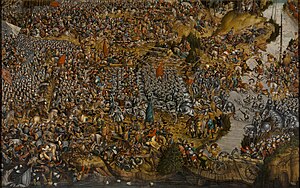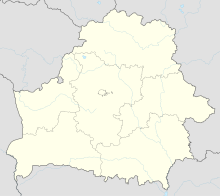
Back اورشا دؤیوشو AZB Uoršas kuova BAT-SMG Бітва пад Оршай (1514) BE Бітва пад Воршай BE-X-OLD Batalla d'Orša Catalan Bitva u Oršy Czech Schlacht bei Orscha (1514) German Batalo de Orŝa EO Batalla de Orsha Spanish نبرد اورشا FA
This article needs additional citations for verification. (September 2011) |
| Battle of Orsha | |||||||
|---|---|---|---|---|---|---|---|
| Part of Lithuanian–Muscovite War (1512-1522) | |||||||
 Battle of Orsha painting attributed to Hans Krell | |||||||
| |||||||
| Belligerents | |||||||
|
Grand Duchy of Lithuania Kingdom of Poland | Grand Duchy of Moscow | ||||||
| Commanders and leaders | |||||||
| Ivan Chelyadnin (POW) | ||||||
| Strength | |||||||
| 12,000 to 35,000[a] | 11,000 to 40,000[b] | ||||||
| Casualties and losses | |||||||
| Unknown | 13,000–40,000 dead and wounded (?) | ||||||
Location within Belarus | |||||||
The Battle of Orsha (Polish: Bitwa pod Orszą, Lithuanian: Oršos mūšis), was fought on 8 September 1514, between the allied forces of the Grand Duchy of Lithuania and the Crown of the Kingdom of Poland, under the command of Lithuanian Grand Hetman Konstanty Ostrogski; and the army of the Grand Duchy of Moscow under Konyushy Ivan Chelyadnin and Kniaz Mikhail Bulgakov-Golitsa. The Battle of Orsha was part of a long series of Muscovite–Lithuanian Wars conducted by Muscovite rulers striving to gather all the former Kievan Rus' lands under their rule.
According to Rerum Moscoviticarum Commentarii by Sigismund von Herberstein, the primary source for information on the battle, the much smaller army of Lithuania–Poland (under 30,000 men) defeated a force of 80,000 Muscovite soldiers, capturing their camp and commander. These numbers and proportions have been disputed by some modern historians.
- ^ Лобин А. Н. К вопросу о численности и составе польско-литовской армии в битве под Оршей в 1514 г. // Праблемы інтэграцыі і iнкарпарацыі ў развіцці Цэнтральнай і Усходняй Еўропы ў перыяд ранняга Новага часу. Мінск, 2010. С. 18–42
- ^ a b Podhorodecki, Leszek (1997). Sławne bitwy Polaków. MADA. pp. 105–106. ISBN 8386170247.
- ^ a b Spieralski, Zdzisław (1965). Wojskowość polska w okresie odrodzenia [w:] Zarys dziejów wojskowości polskiej do roku 1864, t. I, pod red. Janusza Sikorskiego. p. 331.
- ^ a b Wojciechowski, Zygmunt (1946). Zygmunt Stary (1506–1548). p. 50.
- ^ Lobin 2015, p. 31.
- ^ Лобин А. Н. К вопросу о численности вооружённых сил Российского государства в XVI в.//Studia Slavica et Balcanica Petropolitana 2009 Nr 1–2. p. 66
- ^ Alexeev 2009, p. 408.
- ^ Bohun T. Bitwa pod Orsza 08.09.1514 // Rzeczpospolita. 2006. ¹ 4/20. S. 13.
Cite error: There are <ref group=lower-alpha> tags or {{efn}} templates on this page, but the references will not show without a {{reflist|group=lower-alpha}} template or {{notelist}} template (see the help page).
